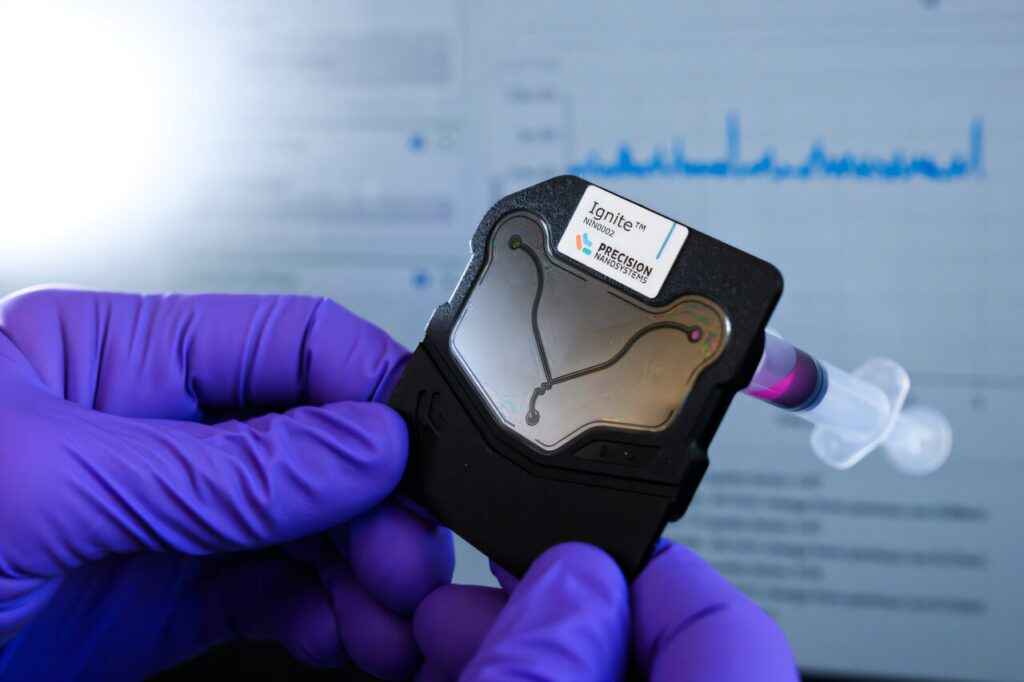Polymer-coated nanoparticles loaded with therapeutic drugs show significant promise for cancer treatment, including ovarian cancer. These particles can be targeted directly to tumors, where they release their payload while avoiding many of the side effects of traditional chemotherapy.
Over the past decade, MIT Institute Professor Paula Hammond and her students have created a variety of these particles using a technique known as layer-by-layer assembly. They’ve shown that the particles can effectively combat cancer in mouse studies.
To help move these nanoparticles closer to human use, the researchers have now come up with a manufacturing technique that allows them to generate larger quantities of the particles, in a fraction of the time.
“There’s a lot of promise with the nanoparticle systems we’ve been developing, and we’ve been really excited more recently with the successes that we’ve been seeing in animal models for our treatments for ovarian cancer in particular,” says Hammond, who is also MIT’s vice provost for faculty and a member of the Koch Institute for Integrative Cancer Research. “Ultimately, we need to be able to bring this to a scale where a company is able to manufacture these on a large level.”
Hammond and Darrell Irvine, a professor of immunology and microbiology at the Scripps Research Institute, are the senior authors of the new study, which is published in Advanced Functional Materials. Ivan Pires, Ph.D. ’24, now a postdoc at Brigham and Women’s Hospital and a visiting scientist at the Koch Institute, and Ezra Gordon ’24 are the lead authors of paper. Heikyung Suh, an MIT research technician, is also an author.
A streamlined process
More than a decade ago, Hammond’s lab developed a novel technique for building nanoparticles with highly controlled architectures. This approach allows layers with different properties to be laid down on the surface of a nanoparticle by alternately exposing the surface to positively and negatively charged polymers.
Each layer can be embedded with drug molecules or other therapeutics. The layers can also carry targeting molecules that help the particles find and enter cancer cells.
Using the strategy that Hammond’s lab originally developed, one layer is applied at a time, and after each application, the particles go through a centrifugation step to remove any excess polymer. This is time-intensive and would be difficult to scale up to large-scale production, the researchers say.
More recently, a graduate student in Hammond’s lab developed an alternative approach to purifying the particles, known as tangential flow filtration. However, while this streamlined the process, it still was limited by its manufacturing complexity and maximum scale of production.
“Although the use of tangential flow filtration is helpful, it’s still a very small-batch process, and a clinical investigation requires that we would have many doses available for a significant number of patients,” Hammond says.
To create a larger-scale manufacturing method, the researchers used a microfluidic mixing device that allows them to sequentially add new polymer layers as the particles flow through a microchannel within the device. For each layer, the researchers can calculate exactly how much polymer is needed, which eliminates the need to purify the particles after each addition.
“That is really important because separations are the most costly and time-consuming steps in these kinds of systems,” Hammond says.
This strategy eliminates the need for manual polymer mixing, streamlines production, and integrates good manufacturing practice (GMP)-compliant processes. The FDA’s GMP requirements ensure that products meet safety standards and can be manufactured in a consistent fashion, which would be highly challenging and costly using the previous step-wise batch process. The microfluidic device that the researchers used in this study is already used for GMP manufacturing of other types of nanoparticles, including mRNA vaccines.
“With the new approach, there’s much less chance of any sort of operator mistake or mishaps,” Pires says. “This is a process that can be readily implemented in GMP, and that’s really the key step here. We can create an innovation within the layer-by-layer nanoparticles and quickly produce it in a manner that we could go into clinical trials with.”
Scaled-up production
Using this approach, the researchers can generate 15 milligrams of nanoparticles (enough for about 50 doses) in just a few minutes, while the original technique would take close to an hour to create the same amount. This could enable the production of more than enough particles for clinical trials and patient use, the researchers say.
“To scale up with this system, you just keep running the chip, and it is much easier to produce more of your material,” Pires says.
To demonstrate their new production technique, the researchers created nanoparticles coated with a cytokine called interleukin-12 (IL-12). Hammond’s lab has previously shown that IL-12 delivered by layer-by-layer nanoparticles can activate key immune cells and slow ovarian tumor growth in mice.
In this study, the researchers found that IL-12-loaded particles manufactured using the new technique showed similar performance as the original layer-by-layer nanoparticles. And, not only do these nanoparticles bind to cancer tissue, but they show a unique ability to not enter the cancer cells. This allows the nanoparticles to serve as markers on the cancer cells that activate the immune system locally in the tumor. In mouse models of ovarian cancer, this treatment can lead to both tumor growth delay and even cures.
The researchers have filed for a patent on the technology and are now working with MIT’s Deshpande Center for Technological Innovation in hopes of potentially forming a company to commercialize the technology. While they are initially focusing on cancers of the abdominal cavity, such as ovarian cancer, the work could also be applied to other types of cancer, including glioblastoma, the researchers say.


